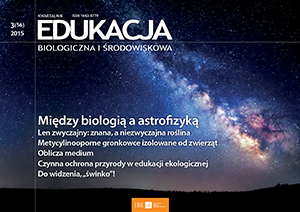Len zwyczajny (Linum usitatissimum L.) – znana, a niezwyczajna roślina
Flax (Linum usitatissimum L.) – a plant with wide cognitive and practical application
Author(s): Aneta Adamczuk, Irena Siegień, Iwona CiereszkoSubject(s): Energy and Environmental Studies, Regional Geography, Post-War period (1950 - 1989)
Published by: Instytut Badań Edukacyjnych
Keywords: oil flax; fiber flax; in vitro cultures; biotechnology;
Summary/Abstract: Flax is an ancient crop plant cultivated around the world for thousands of years. Flax belongs to the family Linaceae, with more than 200 species, and only one species – common flax (Linum usitatissimum L.) has a practical use. Two main products are obtained from flax: oil, which is extracted from seeds, and fibers – produced from stem. Flax fibers are good source of natural fibers for use in the textile industry, construction industry or animal food production. Linseed oil plays an important role in food industry, pharmaceutics or in paint industry. Transgenic flax plants, with various exogenous genes create new products for different applications, such as: flax fibers with high antioxidant level to bandages production or oil with an appropriate proportion of ω-3 and ω-6 fatty acids. Flax has a long history of research in plant tissue culture in vitro. It has been widely used for a range of applications and studies: tissue regeneration experiments, biotechnological studies and many basic developmental, biochemical or ecophysiological studies.
Journal: Edukacja Biologiczna i Środowiskowa
- Issue Year: 2015
- Issue No: 3
- Page Range: 15-21
- Page Count: 7
- Language: Polish
- Content File-PDF

